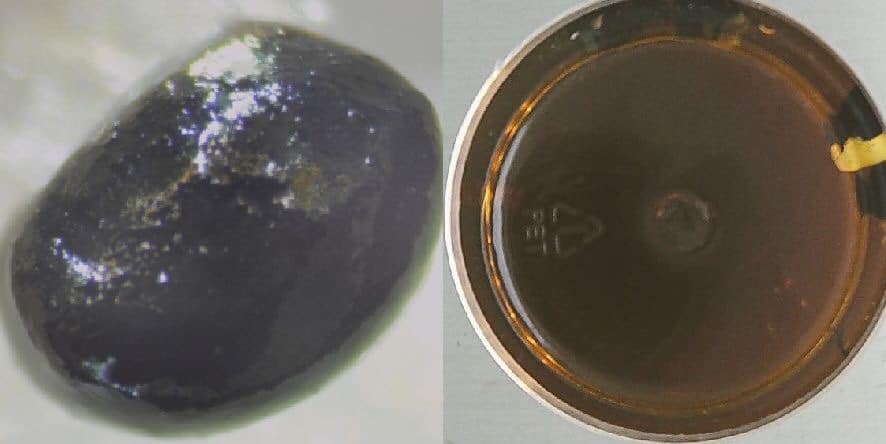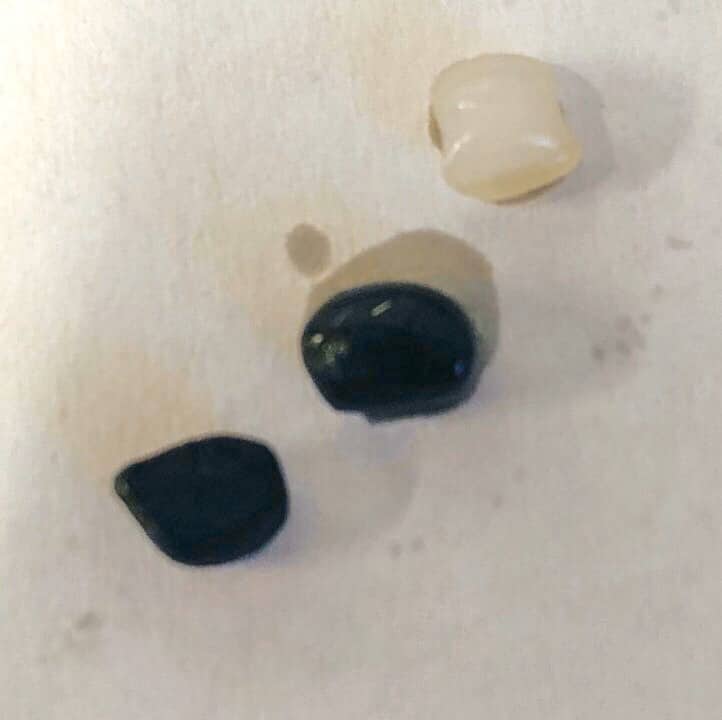
Let me give some background to the mystery of these strange black and white particles appearing in oil samples. We have a new customer operating approximately 50 hydraulic machines that had very strict OEM cleanliness limits so the oil needed to be ISO4406 16/14/12 or cleaner (that is about 16 times cleaner than new oil you would purchase). The systems all run through 2 in-line filters and each machine was connected to 1 micron offline filter cart to give additional cleanliness improvement. So you can imagine they were surprised when we started finding this debris around 10mm particles in the samples. Yes that’s millimetres, not microns and 1000x bigger than anything expected to be found by the client.
Why you can’t just believe a screen read out and you need other data to support it?
The reason this was so surprising was the customer had an on-site laser particle counter measuring the cleanliness of the system continuously and the customer informed the lab they never had a reading above 15/13/10 over the last 12 months and they had a very high end offline filtration system. Every oil sample had come back normal too with the laboratory they used prior to ourselves. In fact the customer didn’t believe us when we first mentioned the material we had found and said it was impossible the oil could be this badly contaminated, so we sent them photographs of the material, which can be seen below. Although the oil is quite dark in colour you can see the material in the sample if you look closely.


What did the customer do?
Both the customer and ourselves believed it to be a poorly taken sample at first. We told the customer to take another sample ensuring they flushed the sample point thoroughly with oil before collecting the sample. However, these re-samples too had these plastic particles that could be seen before even sending to the lab by the client. So the question now stood what was the material?
So what were these black and white particles?
The material was identified as high density polyethylene (plastic) and the source was identified as the material being worked with, as these hydraulic systems were injection moulding machines that manufacture plastic products. The question was with such good filtration how was material like this making it’s way into the system and why had both the inline particle counter and the the previous lab failed to identify this?
How was the material this large in the system?
The customer after seeing particles on the repeat sample opened up the bulk reservoir tank hatch and found what looked a lot like the bottom of a child’s ball pit with over 3kg of plastic material on the tank bottom. It was found that the source of ingress was 2 open breathers to the tank which were facing the a chute style delivery point of the raw plastic materials as they were delivered to the factory. So this material has potentially been building up for many months if not years. Hence the problem was not with the filtration system which was likely stopping this material reaching critical components, but prevention is always better than cure so resolving the ingress point should be the main priority.
Why was this not picked up before it was sent to our lab?
Although it is possible none of this material ever made it into the dozens of historical samples at the customers old lab, this is unlikely as we had consecutive samples with this present.
Hence if it was in the sample why was it not detected? Simple, laboratories work by pipetting samples or drawing the particles up through an auto-sampler, if an object is too big to be sucked up it won’t be analysed. For example most positive displacement pipettes labs use have a diameter of only 1 or 2mm meaning a 10mm object can never be analysed this way. The same is true for online particle counters as if the material is not reaching the counter it can’t be tested. Equally, most lab and indeed inline particle counters have filter strainers at e.g. 250 or 500 microns to stop particles that can damage the particle counter from being analysed. Hence it’s important to do two things:
- Visually inspect samples for particles that ordinarily would never be sucked up by pipettes or lab instruments.
- For wear materials that are large to acid digest the sample, for example through LubeWear technology to make the ordinarily too large undetectable particles detectable again.
Why was there no problems with all this material in the system?
In reality there were problems, but the customer never made the connection. Firstly, they had two pump failures in the last 3 years on this machine. Although these had long since been thrown away during the clean out of the tank they found 13 (unlucky for some) pieces of plastic inside, which would have likely blocked or seized moving parts at some point in the future.
The solution
The solution was to add an air filter to the tank breather to prevent external contaminants entering the system so freely. The customer told us later they sent one of the samples with plastic in to their old lab as they had a couple spare bottles left before switching to us. The sample came back normal as their old lab had not picked up the material. The ironic thing is this can be spotted with the cheapest test to perform as it requires no millions of pounds of testing equipment and just a good pair of eyes, so there is really no excuse for any lab big or small missing this.
At oil analysis laboratories we visually inspect every single sample. Some labs don’t look at all, whilst others do only certain sample types, but for us we inspect every single one before they undergo a thorough set of lab analyses. I have in my time spotted all wealth of problems in a sample just by looking which has prompted the lab to perform extra potentially non routine tests to support the findings. We have literally seen it all as the next short case study will highlight.
Our analysis even saved a customer’s marriage.
This is a bold statement to end with and you may think this is an unfounded claim. It’s not just visual checks but we use all our senses in conjunction with the testing such as smell and even hearing. Yes, I have had occasions where hearing has spotted things too. For example, I have had a sample that was very sooty Diesel engine oil, so not possible to see much in the sample, but the act of shaking the sample before doing the crackle test one of my team heard a strange rattle. We drained the bottle and fished out what we thought was a thick washer type fitting at first, but once we cleaned it up we soon realised it was a man’s wedding ring. We looked who had taken the sample from our pre-reg data to ask had he or any of his colleagues lost a wedding ring. The joy was almost palpable on the telephone as indeed one of the fitters had lost his ring in an engine rebuild. They had assumed it had fallen off later in the day when he noticed, but it must have been before the oil drain from the sump bottom (a not ideal sample practice) in which a sample was taken. In this case not taking by the dipstick actually worked out quite fortuitous for the client. I am also told he won’t skip wearing gloves in future too.
We can’t promise an oil sample can save your marriage as in this scenario, but we can certainly help you save your machinery by spotting things other labs miss. If you would like to find out more about oil analysis please click the contact us button to get in touch.

